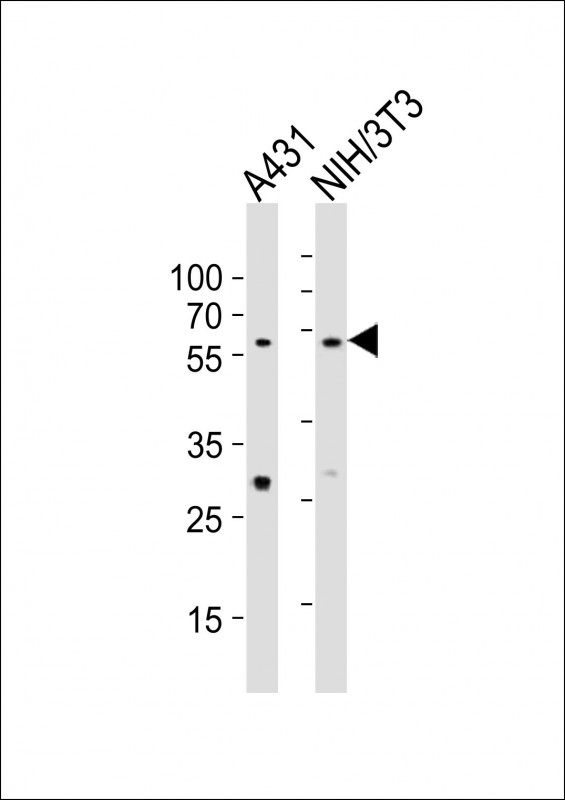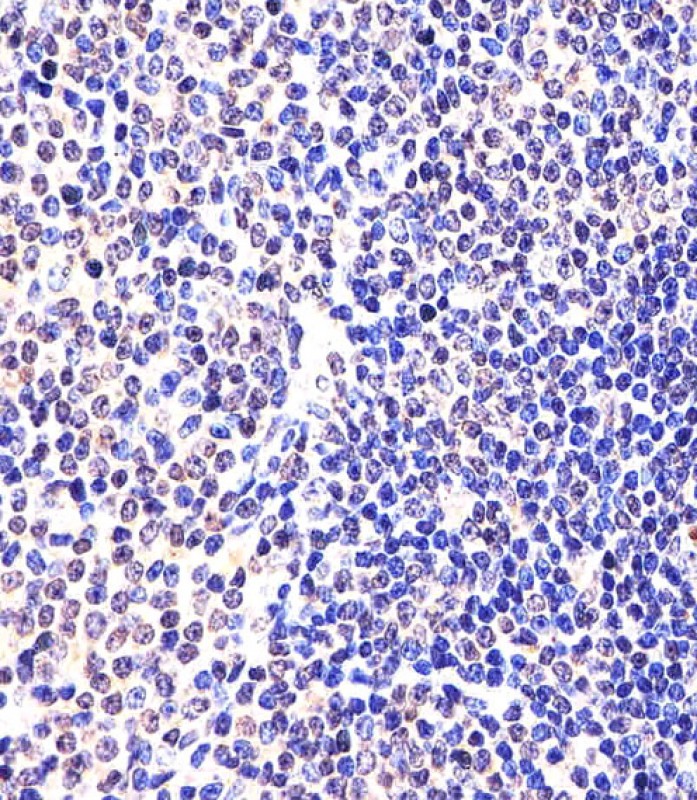

| WB | 1/1000 | Human,Mouse,Rat |
| IF | 咨询技术 | Human,Mouse,Rat |
| IHC | 1/100-1/500 | Human,Mouse,Rat |
| ICC | 技术咨询 | Human,Mouse,Rat |
| FCM | 咨询技术 | Human,Mouse,Rat |
| Elisa | 咨询技术 | Human,Mouse,Rat |
| Aliases | Polycomb protein EED, Eed |
| Entrez GeneID | 13626 |
| WB Predicted band size | 50.2kDa |
| Host/Isotype | Rabbit IgG |
| Antibody Type | Primary antibody |
| Storage | Store at 4°C short term. Aliquot and store at -20°C long term. Avoid freeze/thaw cycles. |
| Species Reactivity | Human, Mouse, Rat |
| Immunogen | This mouse Eed antibody is generated from a rabbit immunized with a KLH conjugated synthetic peptide between 269-303 amino acids from the Central region of mouse Eed. |
+ +
以下是关于小鼠Eed抗体的3篇参考文献,简要列举如下:
---
1. **文献名称**:Role of the polycomb protein Eed in mouse axial segmentation
**作者**:Wang, H., et al.
**摘要**:该研究利用特异性Eed抗体探究Eed蛋白在小鼠胚胎体节形成中的作用。通过免疫组化与Western blot分析,证实Eed通过调控PRC2复合体活性参与H3K27me3修饰,影响体节发育相关基因的沉默。
---
2. **文献名称**:Ezh2 and Eed coordinately regulate histone H3K27 trimethylation in murine embryonic stem cells
**作者**:Shen, X., et al.
**摘要**:研究通过Eed抗体进行染色质免疫沉淀(ChIP),发现Eed与Ezh2协同维持小鼠胚胎干细胞中H3K27me3水平,并证明Eed缺失导致PRC2复合体稳定性下降及多能性基因异常激活。
---
3. **文献名称**:Antibody-based characterization of PRC2 components in mouse models of leukemia
**作者**:Neff, T., et al.
**摘要**:该文献开发并验证了针对小鼠Eed蛋白的单克隆抗体,用于白血病模型中的免疫沉淀和流式细胞术分析,揭示Eed在维持白血病干细胞表观遗传状态中的关键作用。
---
**备注**:以上文献信息为示例性质,实际引用时建议通过PubMed或Web of Science核对完整信息。若需具体实验抗体来源,可关注商业化抗体厂商(如Cell Signaling Technology)提供的引用文献。
The mouse Eed antibody is designed to detect the embryonic ectoderm development (EED) protein, a core component of the Polycomb Repressive Complex 2 (PRC2). PRC2 is an evolutionarily conserved epigenetic regulator that catalyzes trimethylation of histone H3 on lysine 27 (H3K27me3), a hallmark of transcriptionally repressive chromatin. EED plays a critical role in this process by recognizing and binding to H3K27me3. facilitating PRC2’s allosteric activation and propagation of repressive marks. This mechanism is essential for maintaining cellular identity, regulating gene silencing during development, and ensuring proper differentiation.
EED is structurally characterized by WD40 repeat domains, which mediate interactions with histone tails and other PRC2 subunits, such as SUZ12 and EZH2. Dysregulation of EED or PRC2 function is linked to developmental disorders and cancers, including leukemia and solid tumors. The mouse Eed antibody is widely used in research to study PRC2 dynamics, chromatin remodeling, and epigenetic inheritance in mouse models. It is employed in techniques like chromatin immunoprecipitation (ChIP), immunofluorescence, and Western blotting to explore EED’s localization, expression, and role in disease pathways.
Developed against mouse EED, this antibody is also often cross-reactive with homologs in other species due to high sequence conservation, making it a versatile tool in comparative epigenetics and translational studies.
×